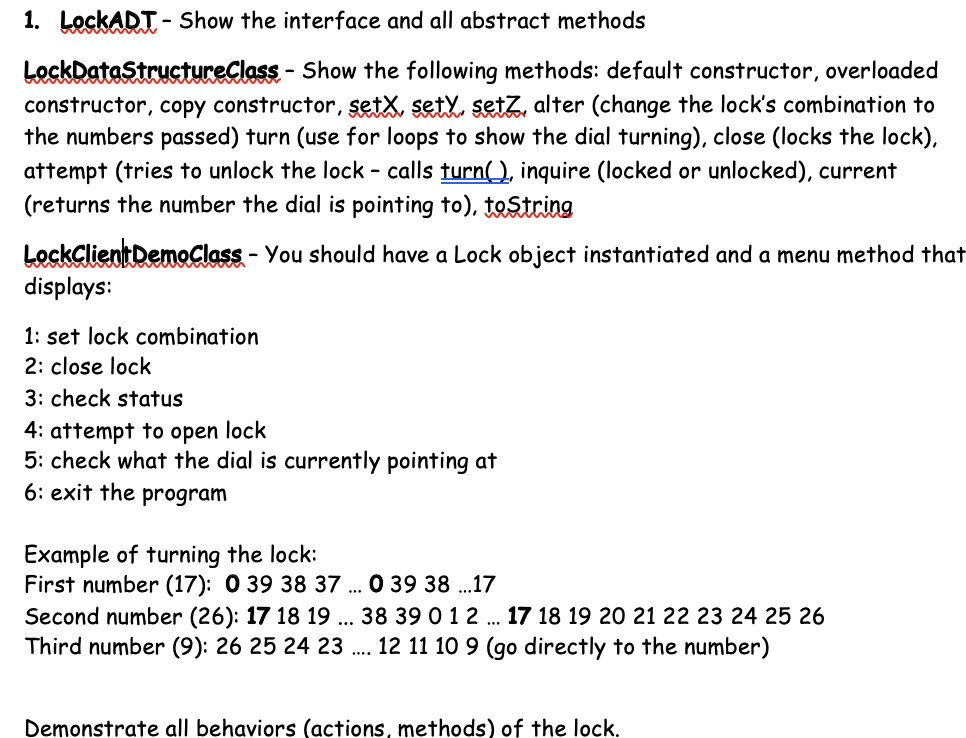1. LockADT - Show the interface and all abstract methods LockDataStructureClass - Show the following methods: default constructor, overloaded constructor, copy constructor, setX, setX, setz, alter (change the lock's combination to the numbers passed) turn (use for loops to show the dial turning), close (locks the lock), attempt (tries to unlock the lock - calls turn(_), inquire (locked or unlocked), current (returns the number the dial is pointing to), toString LockClientDemoClass - You should have a Lock object instantiated and a menu method tho displays: 1: set lock combination 2: close lock 3: check status 4: attempt to open lock 5: check what the dial is currently pointing at 6: exit the program Example of turning the lock: First number (17): 0 39 38 37 ... O 39 38 ..17 Second number (26): 17 18 19 ... 38 39 0 1 2 .. 17 18 19 20 21 22 23 24 25 26 Third number (9): 26 25 24 23 .. 12 11 10 9 (go directly to the number)
1. LockADT - Show the interface and all abstract methods LockDataStructureClass - Show the following methods: default constructor, overloaded constructor, copy constructor, setX, setX, setz, alter (change the lock's combination to the numbers passed) turn (use for loops to show the dial turning), close (locks the lock), attempt (tries to unlock the lock - calls turn(_), inquire (locked or unlocked), current (returns the number the dial is pointing to), toString LockClientDemoClass - You should have a Lock object instantiated and a menu method tho displays: 1: set lock combination 2: close lock 3: check status 4: attempt to open lock 5: check what the dial is currently pointing at 6: exit the program Example of turning the lock: First number (17): 0 39 38 37 ... O 39 38 ..17 Second number (26): 17 18 19 ... 38 39 0 1 2 .. 17 18 19 20 21 22 23 24 25 26 Third number (9): 26 25 24 23 .. 12 11 10 9 (go directly to the number)
Chapter10: Introduction To Inheritance
Section: Chapter Questions
Problem 20RQ
Related questions
Question
follow the directons on the photo,
don't use others answers,
screenshot of output
Thank you!!!

Transcribed Image Text:1. LockADT - Show the interface and all abstract methods
LockDataStructureClass - Show the following methods: default constructor, overloaded
constructor, copy constructor, setx, sety, setzZ, alter (change the lock's combination to
the numbers passed) turn (use for loops to show the dial turning), close (locks the lock),
attempt (tries to unlock the lock - calls turn(), inquire (locked or unlocked), current
(returns the number the dial is pointing to), tostring
LockClientDemoClass - You should have a Lock object instantiated and a menu method that
displays:
1: set lock combination
2: close lock
3: check status
4: attempt to open lock
5: check what the dial is currently pointing at
6: exit the program
Example of turning the lock:
First number (17): 0 39 38 37 .. 0 39 38 .17
Second number (26): 17 18 19 ... 38 39 0 1 2 . 17 18 19 20 21 22 23 24 25 26
Third number (9): 26 25 24 23 . 12 11 10 9 (go directly to the number)
Demonstrate all behaviors (actions, methods) of the lock.
Expert Solution
This question has been solved!
Explore an expertly crafted, step-by-step solution for a thorough understanding of key concepts.
This is a popular solution!
Trending now
This is a popular solution!
Step by step
Solved in 2 steps with 2 images

Recommended textbooks for you

Microsoft Visual C#
Computer Science
ISBN:
9781337102100
Author:
Joyce, Farrell.
Publisher:
Cengage Learning,

Microsoft Visual C#
Computer Science
ISBN:
9781337102100
Author:
Joyce, Farrell.
Publisher:
Cengage Learning,